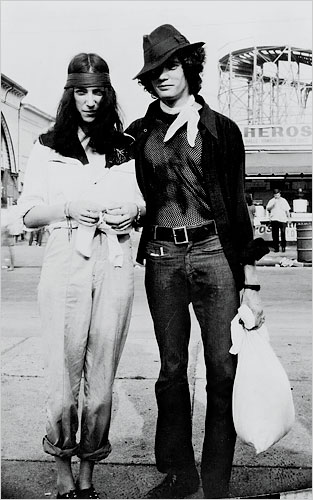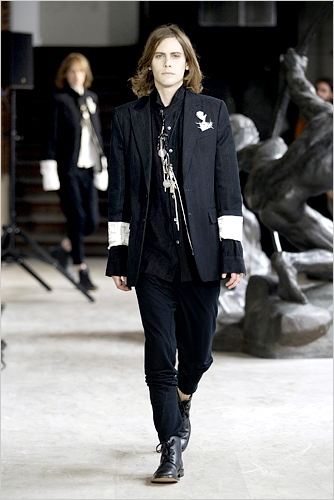Try and understand Patti Smith
August 9, 2011
Após o fechamento, em primeiro de agosto, do famoso Hotel Chelsea em Nova York onde Patti Smith morou durante o início dos anos 70 com seu melhor amigo e companheiro de algum tempo Robert Mapplethorpe, e retornou sozinha nos anos 90, a Visíveis Virtudes traz partes de uma entrevista da poeta e cantora punk concebida ao The New York Times ano passado, em sua mesa de esquina preferida do restaurante Da Silvano em Greenwich Village.
“Meu estilo diz `Olhe para mim, não olhe para mim,`” ela disse, com uma certa impaciência que perturbava sua tranquilidade aparente “É, ‘eu não me preocupo com o que você pensa.’” Então foi uma surpresa descobrir que a jaqueta que Patti Smith usava foi criada por Ann Demeulemeester, a sacerdotista da vanguarda chic parisiense. O jeans era Ralph Lauren e as botas, um presente de Johnny Depp, foram usadas por ele no papel de chapeleiro maluco em “Alice no País das Maravilhas”.
“Ela é muito consciente de seu estilo, e o controla” disse Demeulemeester, amiga e colaboradora de longo tempo. “É sobre ter consciência de quem você é e usar todo seu poder para comunicar essa mensagem.” Entre apresentações em eventos como a noite final do CBGB, o lendário clube na rua Bowery, e inúmeras aparições públicas ao longo da última década, ela se manteve fiel ao seu estilo assinatura, uma mistura de glamour e resistência.
Essa consistência estabeleceu Patti Smith, hoje com 64 anos, como lançadora de tendências de várias gerações – quantas meninas imitam seu look vestindo jeans, boyfriend jackets e camisas brancas sem perceber a influência? E seu estilo ressoa o de designers tão diversos como Christophe Decarnin (ex-diretor criativo) da Balmain e Limi Yamamoto da Limi Feu, para quem Smith tem sido um tipo de musa espiritual. “A capacidade dela de aceitar tudo que acontece com ela ,” afirmou Yamamoto recentemente, é uma constante inspiração.
As paixões de Smith refletem seu estilo, um pastiche baseado em seus heróis culturais. A qualquer momento, pode fazer referência à Veruschka, a modelo amazona dos anos 60, ou a Keith Richards e John Lennon. Ela andou por meses por lojas à procura de calças listradas de linho que evocavam Lennon porque, disse ela, “algo naquelas calças falaram para mim de mim mesma.”
Ela gosta de amarrar suas camisas brancas na cintura em homenagem à Ava Gardner. As gravatas masculinas que usa são uma refercência a Frank Sinatra e Bob Dylan. Como as jaquetas biker que ela garimpou nas lojas vintage no Bowery, elas são totens.
Smith, que deixou o colégio aos 20 anos, cultivou um olhar para a moda estudando filmes como Cinderela em Paris (Funny Face) de 1957 e fotografias de estrelas de cinema na Photoplay e de modelos dos catálogos da Sears nos anos 50. Ela teve o primeiro contato com a high fashion aos sete anos ao encontrar uma pilha de revistas Vogue e Harper’s Bazaar. “Estudei as páginas das revistas durante todos os anos 60. Me tornei especialista”.
A loja The Salvation Army em Camden, N.J, próxima a sua casa, era onde os ricos descartavam roupas de estilistas famosos e muitas foram parar no guarda-roupas de Smith.
No colégio, Smith achava normal usar um vestido Dior vintage ou calças capri cor de rosa com uma capa de chuva verde em homenagem à Audrey Hepburn, quem em “Cinderela em Paris” era para Smith “a garota beatnik na livraria que queria ir a Paris. Era eu na época”. Ela também não escondia seu romanticismo efusivo. “As pessoas não sabiam disso, mas eu adoro vestidos de festa”, disse ela. “Iadoro o corte, a arquitetura e a idéia das mãos de tantas costureiras trabalhando neles.”
Ela junta referências com um olhar atento; elas servem em seu livro “Just Kids” como umdisparador de mnemônicas, levando-a de volta ao carnaval que era o arenoso St. Marks Place no começo dos anos 70, o espaço repleto de arte que dividia com Mapplethorpe no Chelsea Hotel, e a mesa redonda nos fundos do Max, uma vez lugar de Andy Warhol e seus amigos.
Naquele período ela começou a dar nomes divertidos às suas roupas . Havia o chapéu de palha “Song of the South”, a jaqueta Br’er Rabbit , botas de trabalho e calças dobradas; o “jogador de tênis em luto,” uma roupa toda preta com tênis Keds brancos; e sua Anna Karina em “Bande à part”: agasalho preto, saia xadrês, meia preta e sapatilhas.
Nunca aversa a uma performance, ela revelou: aquelas roupas eram, afinal, para torná-la inesquecível. Pousando para uma foto para sua amiga Judy Linn, Smith acendeu um Kool, na expectativa de que isso poderia causar intimidamento. “Sei que sou uma fumante de mentira,” ela confessou a Linn, “mas não estou fazendo mal a ninguém e, além disso, tenho que cuidar da minha imagem.”
Ainda assim, ela insiste não ser uma atriz. “Não tenho a disciplina nem o desejo de ser outra pessoa.”. “Gosto de me sentir confortável,” disse ela. “Sexo nunca foi minha história. Apenas quis me sentir eu mesma.”
——————–
Following the closure, on August 1, of the the infamous Hotel Chelsea in New York where Patti Smith lived during the early 70s with best friend and sometime lover Robert Mapplethorpe and returned alone in the 90s, Visiveis Virtudes brings parts of an interview given by the legendary punk poet and musician to The New York Times last year, at her customary corner table at Da Silvano em Greenwich Village.
“My style says ‘Look at me, don’t look at me,’” she said, a hint of testiness ruffling her easy composure. “It’s, ‘I don’t care what you think.’” So it was surprising to learn that her roomy gray jacket, with cuffs that unfasten at the wrist, was designed by Ann Demeulemeester, a high priestess of Parisian vanguard chic. Her jeans were Ralph Lauren, prized by Ms. Smith for their racy lines. Her boots, a gift from Johnny Depp, who wore them as the Mad Hatter in “Alice in Wonderland,” were the perfect fit, Ms. Smith exulted, “like when the magic cobbler made your shoes.”
“She is very aware of her style and she controls it,” said Ms. Demeulemeester, a longtime friend and fashion collaborator. (Ms. Smith favors the designer’s mannish white shirts, inspired by the one she wore on the cover of her debut album, “Horses”) “It’s about being conscious of who you are and using all the strength you have to communicate that”. “The thing I’ve always liked about performing,” she said, storm clouds gathering in her eyes, “is that I decide what I want to wear, whether I want to comb my hair. No one ever told me what to do, and no one tells me now.”
A star attraction at iconic events like the final night of CBGB, the fabled Bowery club where she performed as a girl, and at a string of public outings throughout the past decade, she has cleaved to her signature style, an unlikely fusion of glamour and grit.
That constancy has made Ms. Smith a trendsetter for several generations — how many young girls emulate her look of pegged jeans, boyfriend jackets and white shirts without ever realizing it? And her style resonates with designers as diverse as Christophe Decarnin of Balmain and Limi Yamamoto of Limi Feu, for whom Ms. Smith has been a kind of spiritual muse. “The capacity to accept anything that happens to her,” Ms. Yamamoto said recently, is a source of constant inspiration.
Her abiding passions are reflected in her style, a thoughtful pastiche modeled on her cultural heroes. At any time, it may owe a debt to the Harris tweed jackets she spied on a couple at the Metropolitan Museum, to Veruschka, the ’60s runway Amazon, or to vintage Keith Richards and John Lennon. She combed shops for months in search of the striped linen trousers that evoked Mr. Lennon because, she said, “something in those pants spoke to me of myself.”
She likes to knot her white shirts at the waist in homage to Ava Gardner. Her stringy men’s ties are a simultaneous nod to Frank Sinatra and Bob Dylan. Like the beat-up biker jackets she hunted down long ago in thrift shops on the Bowery, they are totems.
Ms. Smith, who dropped out of college at 20, cultivated a fashion eye by studying movies like “Funny Face” and photographs of movie stars in Photoplay and of models in 1950s Sears catalogs. She encountered high fashion at 7 when she chanced on a cache of discarded Vogues and Harper’s Bazaars. At the time, fashion magazines “were such a window into the culture,” she added wistfully. “There would be a spread on Morocco, another on what to wear to a fox hunt.“I studied those pages all through the ’60s. I became very knowledgeable.”
”She refined her expertise. The Salvation Army in Camden, N.J., near her home, a dumping ground for the castoffs of the rich, was filled with high-end labels, some that made their way into her closet. In high school Ms. Smith thought nothing of wearing used Dior dresses or pink shantung capri pants with a Kelly green raincoat in honor of Audrey Hepburn, who in “Funny Face” was for Smith “the beatnik girl in the bookstore who wants to go to Paris. That was me at the time”. Nor did she mask her effusive romanticism. “People wouldn’t know this about me, but I adore ball gowns,” she said. “I love their cut, their architecture and the thought of the hands of so many seamstresses working on them.”
She gathers references with a magpie eye; they serve in her book “Just Kids” as mnemonic triggers, taking her back to the gritty carnival that was St. Marks Place in the early ’70s, the cramped, art-strewn quarters she shared with Mapplethorpe at the Chelsea Hotel, and the coveted round table in the back room at Max’s, once home to Andy Warhol and his entourage.
In those days she took to giving fanciful names to her outfits. There was her “Song of the South” get-up: straw hat, Br’er Rabbit jacket, work boots and pegged pants; the “tennis player in mourning,” a black-on-black ensemble accessorized for evening with white Keds; and her Anna Karina in “Bande à part”: dark sweater, plaid skirt, black tights and flats.
Never averse to role-playing, she reveled in those costumes: they were meant, after all, to render her unforgettable. Posing for a photograph for her friend Judy Linn, Ms. Smith lighted a Kool, hoping, as she writes, that it would lend her a bit of professional swagger. “I know I’m a fake smoker,” she confided to Ms. Linn, “but I’m not hurting anybody and besides I gotta enhance my image. ”Yet she she’s no actress, Ms. Smith insists. “I have neither the discipline nor the desire to turn into someone else”.“I like to be comfortable,” she said evenly. “Sex has never been my thing. I just wanted to feel like myself.”

IN CONEY ISLAND Ms. Smith and Robert Mapplethorpe in 1969

Ann Demeulemeester’s designs are favorites


